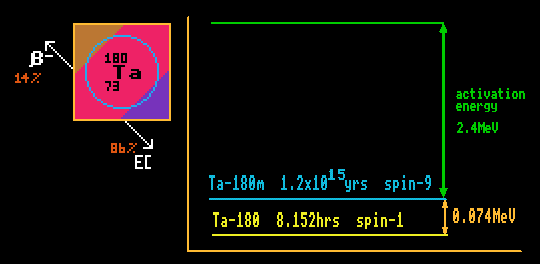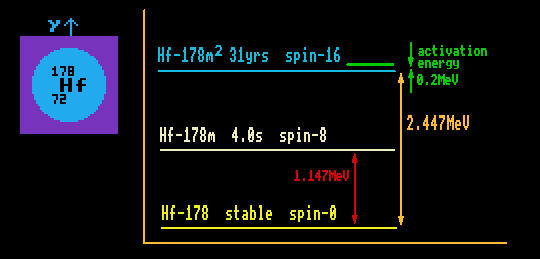

Metastable isomeric states have a higher energy than their ground states, by only 0.074MeV in the case of Ta-180m, and if the isomer could be stimulated (by external gamma-rays) into decaying sooner, the result would be a nuclear laser, a million times more powerful than its atomic equivalent. The gamma-rays boost the energy of the isomeric state such that the nucleus briefly becomes spherical in the switch from prolate to oblate, and during this brief moment, there is no preferred spin axis, and the decay to the ground state is un-inhibited. The isomer decays. The beauty of this technique is that the substance is non-radioactive until stimulated. Unfortunately, in the case of Ta-180m, the energy of the gamma-ray required for this boost, 2.4MeV, the activation energy, is 30 times the extra energy released by the subsequent stimulated decay, 0.074MeV.
The activation energy of 2.4MeV boosts the Ta-180m into it's so-called 'k-mixing state', where it is in two states at the same time, a quantum superposition of states, and in this state it is neither prolate nor oblate, but both at the same time, and it spends a proportion of the time in the spherical state where there is no preferred spin axis. It is during the time it is in the spherical state that it can decay easily because there is no constraint on the spin carried away by the emitted gamma ray. The gamma ray is emitted with an energy of 0.074MeV, the difference in energy between the metastable and ground states.
![]()

The isotope of another element, hafnium-178m, has a much higher metastable state energy, 2.447MeV, and a much lower activation energy, just 0.2MeV, in the X-ray region, releasing 100 times the activation energy. In fact hafnium-178 has two metastable states, Hf-178m and Hf-178m2. The spin of the first excited state, Hf-178m, is spin-8 but the halflife is a very short 4 second. This state is of no use. It is the second metastable state, Hf-178m2 that is important. This state has spin-16 and a halflife of 31 years, and is a high 2.447 MeV higher than the ground state, Hf-178. Unfortunately, because of the short halflife of only 31 years, it is not present on Earth and has to be manufactured artificially. The spin difference between ground state and metastable state is 16 units. Stimulating this metastable isomer into decaying by irradiating it with 0.2 MeV Xrays (the activation energy required to bump Hf-178m2 to it's k-mixing state) would yield a much higher energy gain. So far, a shortening of the halflife by only 4% has been observed by stimulating hafnium-178m with X-rays. Research continues for more promising isomers.
It should be noted that this mechanism of stimulated emission is not the same as the stimulated emission obtainable in optical lasers; in the case of lasers the stimulating radiation is the same wavelength as that emitted, thus each emitted photon stimulates the emission of more identical photons, in unison, amplifying the beam which is coherent. In the case of the stimulated gamma emission here, a different wavelength photon is emitted from the stimulating one, a crucial difference. Also, in an optical laser, the beam is bounced back and forth between two parallel mirrors, effectively increasing the path length of the amplifying material such that the gain is above unity. In the case of any possible gamma ray laser, there are no known mirrors for gamma rays (just grazing-incidence reflectors) so the length of material the gamma ray beam passed through would have to be sufficientlu long that the gain is above unity. Research continues to find nuclear isomers that may be stimulated by the same wavelength that they emit, to produce what would be a gamma ray laser.
See Quantum Nucleonic Reactor.
![]()
![]()